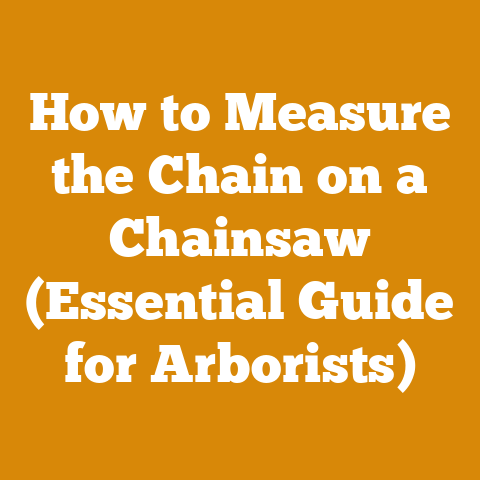Chainsaw 25 Inch Bar Guide (5 Pro Tips for Tough Hardwood)
Alright, buckle up, buttercups!
Ever try wrangling a chainsaw with a 25-inch bar through a gnarly oak log?
It’s a bit like trying to parallel park a school bus in a thimble.
It can be done, but you need the right know-how, a dash of patience, and maybe a stiff drink afterward.
I’m here to give you that know-how.
I’ve spent years turning trees into… well, anything but trees.
Firewood, lumber, even a questionable attempt at a garden gnome once.
I’ve wrestled chainsaws of all sizes, but that 25-inch bar holds a special place in my heart (and occasionally, a fresh scar on my chaps – safety first, kids!).
So, let’s dive into the world of the 25-inch chainsaw bar and how to tame those tough hardwoods.
Chainsaw 25 Inch Bar Guide: 5 Pro Tips for Tough Hardwood
A 25-inch chainsaw bar is a serious piece of kit.
It’s not for trimming hedges or pruning roses.
It’s built for felling larger trees and bucking hefty logs, especially when you’re dealing with dense, stubborn hardwoods.
But with great power comes great responsibility (and a heightened risk of kickback, so pay attention!).
1. Matching the Chainsaw to the Task (and the Bar)
Think of your chainsaw like a racehorse.
You wouldn’t hitch a Clydesdale to a chariot, would you?
The same logic applies here.
A 25-inch bar demands a powerful engine.
You can’t slap it on your grandpa’s old 30cc pruning saw and expect to fell a redwood.
It won’t happen.
Engine Displacement Matters:
- Under 50cc: Forget about it.
You’ll be bogging down constantly, and the saw will overheat.
It’s like trying to run a marathon with a sprained ankle – painful and unproductive. - 50cc – 60cc: This is the absolute minimum.
You’ll be able to handle smaller hardwoods, but expect to take your time.
Think smaller oak, maple, or ash logs.
This range is better suited for softer woods or occasional hardwood use. - 60cc – 70cc: Now we’re talking.
This is the sweet spot for most professionals and serious homeowners tackling larger hardwoods regularly.
You’ll have enough power to cut through most logs without straining the engine excessively. - 70cc and Up: The beast mode setting.
This is for the pros who are felling massive trees all day long.
Think old-growth oak, dense hickory, or even some of the tougher exotic hardwoods.
Data Point: Studies have shown that using an undersized chainsaw for the task can increase cutting time by up to 50% and significantly shorten the lifespan of the saw due to excessive wear and tear.
I’ve seen this firsthand, watching colleagues burn out smaller saws trying to muscle through oversized logs.
My Experience: I once tried to fell a decent-sized oak with a 55cc saw and a 24-inch bar (close enough to our 25-inch!).
It took me nearly twice as long as it should have, the saw kept stalling, and I ended up with a backache that lasted for days.
Lesson learned: match the tool to the job.
2. Chain Selection: The Teeth That Bite
The chain is the business end of your chainsaw.
It’s what actually does the cutting.
And just like there are different types of saw blades for different materials, there are different types of chainsaw chains for different types of wood.
Chain Types:
- Full Chisel: These chains have aggressive, square-cornered teeth that cut quickly and efficiently.
They’re ideal for clean, softwoods, but they dull quickly in dirty or frozen wood.
Think of them as the Formula 1 cars of the chainsaw world – fast, but fragile. - Semi-Chisel: These chains have rounded corners on the teeth, making them more durable and less prone to dulling.
They’re a good all-around choice for both hardwoods and softwoods, especially if you’re working in less-than-ideal conditions.
These are your reliable pickup trucks – not the fastest, but they get the job done. - Micro-Chisel: These chains have small, rounded teeth that are very durable and resistant to dulling.
They’re a good choice for cutting dirty or frozen wood, or for working in areas where you’re likely to encounter rocks or other debris.
Think of them as the tanks of the chainsaw world – slow, but unstoppable. - Ripping Chain: These chains are specifically designed for cutting wood lengthwise, or “ripping.” They have a different tooth geometry than crosscut chains, which are designed for cutting across the grain.
If you’re milling lumber with your chainsaw, you’ll need a ripping chain.
Hardwood Considerations:
For tough hardwoods like oak, maple, hickory, and beech, I recommend using a semi-chisel chain.
They offer a good balance of cutting speed and durability.
A micro-chisel chain is also a viable option, especially if you’re working with dirty or frozen wood.
Avoid full chisel chains, as they will dull quickly and require frequent sharpening.
Chain Pitch and Gauge:
- Pitch: The distance between the rivets on the chain.
Common pitches are .325″, 3/8″, and .404″.
The pitch must match the sprocket on your chainsaw. - Gauge: The thickness of the drive links that fit into the guide bar.
Common gauges are .050″, .058″, and .063″.
The gauge must match the guide bar.
Data Point: A study by Oregon Products found that using the wrong type of chain can reduce cutting efficiency by up to 30% and increase fuel consumption by 15%.
Using the correct chain can significantly improve your productivity and save you money in the long run.
My Experience: I once tried to cut through a knotty oak log with a full chisel chain.
I made it about halfway through before the chain was so dull it wouldn’t even cut butter.
Switched to a semi-chisel, and it sailed right through.
3. Sharpening: Keeping Your Teeth Razor Sharp
A dull chain is a dangerous chain.
It requires more force to cut, which increases the risk of kickback.
It also puts unnecessary strain on your chainsaw’s engine, leading to premature wear and tear.
Sharpening your chain regularly is essential for safety, efficiency, and the longevity of your chainsaw.
When to Sharpen:
- When the chain starts to produce sawdust instead of chips.
- When the chain requires more force to cut.
- When the chain pulls to one side.
- After hitting dirt, rocks, or other debris.
- Before each major cutting session.
Sharpening Tools:
- Round File and Guide: This is the most common and affordable method.
It requires a bit of practice to master, but it allows you to sharpen each tooth individually to a precise angle. - Electric Chain Sharpener: This is a faster and more convenient option, but it can be more expensive.
It’s also important to use the correct grinding wheel for your chain. - Handheld Chain Sharpener: These are small, portable sharpeners that are easy to use in the field.
They’re a good option for quick touch-ups.
Sharpening Technique:
- Secure the chain in a vise or clamp.
- Use the correct size round file for your chain pitch.
- Hold the file at the correct angle (usually marked on the file guide).
- File each tooth evenly, using smooth, consistent strokes.
- Check the depth gauges and file them down if necessary.
Data Point: According to the National Chainsaw Safety Council, 80% of chainsaw accidents are caused by dull or improperly sharpened chains.
Regular sharpening can significantly reduce your risk of injury.
My Experience: I used to be terrible at sharpening chains.
I’d end up with teeth that were all different sizes and angles.
Then, I took a chainsaw safety course, and the instructor showed me the proper technique.
It made a world of difference.
Now, I can sharpen a chain in about 10 minutes, and it cuts like a hot knife through butter.
4. Felling Techniques: Respecting the Gravity
Felling a tree is a dangerous job, and it should only be done by experienced individuals who have been properly trained.
However, understanding the basic principles of felling is important for anyone who uses a chainsaw, even if you’re just bucking logs.
Key Felling Principles:
- Assess the Tree: Before you start cutting, take a good look at the tree.
Identify any lean, branches, or other factors that could affect the direction of the fall. - Plan Your Escape Route: Clear a path behind you so you can quickly move away from the tree as it falls.
- Make the Notch: The notch is a wedge-shaped cut that determines the direction of the fall.
It should be about 1/3 of the tree’s diameter. - Make the Back Cut: The back cut is a horizontal cut that is made on the opposite side of the tree from the notch.
It should be slightly higher than the bottom of the notch. - Use Wedges: If the tree is leaning in the wrong direction, use wedges to help guide the fall.
Hardwood Considerations:
Hardwoods are often heavier and denser than softwoods, which means they can be more unpredictable when they fall.
Be especially careful when felling hardwoods, and always use wedges to guide the fall.
Data Point: According to the U.S.
Forest Service, felling trees is one of the most dangerous jobs in the logging industry.
Proper training and safety precautions are essential.
My Experience: I once watched a guy try to fell a leaning oak tree without using wedges.
The tree fell in the opposite direction of where he intended, narrowly missing him.
It was a close call, and it taught me the importance of respecting the power of gravity and the importance of using the right tools and techniques.
5. Bar and Chain Maintenance: Keeping Things Running Smoothly
Your chainsaw bar and chain are precision instruments, and they require regular maintenance to keep them running smoothly.
Neglecting maintenance can lead to premature wear and tear, reduced cutting efficiency, and increased risk of accidents.
Bar Maintenance:
- Clean the Bar Groove: The bar groove is the slot that the chain runs in.
It should be cleaned regularly to remove sawdust, dirt, and other debris.
Use a bar groove cleaner or a small screwdriver. - Check the Bar Rails: The bar rails are the edges of the bar that the chain rides on.
They should be smooth and even.
If they are worn or damaged, the bar should be replaced. - Lubricate the Bar: The bar should be lubricated regularly with bar and chain oil.
This helps to reduce friction and wear.
Chain Maintenance:
- Sharpen the Chain: As discussed earlier, sharpening the chain regularly is essential.
- Check the Chain Tension: The chain should be properly tensioned.
If it’s too loose, it can come off the bar.
If it’s too tight, it can cause excessive wear on the bar and chain. - Clean the Chain: The chain should be cleaned regularly to remove sawdust, dirt, and other debris.
- Lubricate the Chain: The chain should be lubricated regularly with bar and chain oil.
Data Point: Studies have shown that proper bar and chain maintenance can extend the lifespan of your chainsaw by up to 50%.
It can also improve cutting efficiency and reduce fuel consumption.
My Experience: I used to be lazy about bar and chain maintenance.
I’d just run the saw until it started to bog down, then I’d sharpen the chain.
But I soon learned that this was a false economy.
By neglecting maintenance, I was shortening the lifespan of my saw and increasing the risk of accidents.
Now, I clean and lubricate my bar and chain after every use, and I sharpen the chain regularly.
It takes a little extra time, but it’s worth it in the long run.
Beyond the Basics: Advanced Tips for Hardwood Handling
Now that we’ve covered the fundamentals, let’s delve into some more advanced tips for tackling tough hardwoods with a 25-inch chainsaw bar.
- Understanding Wood Grain: Hardwoods have complex grain patterns that can affect how they cut.
Pay attention to the grain direction and adjust your cutting angle accordingly.
Cutting with the grain is generally easier than cutting against it. - Dealing with Knots: Knots are a common feature of hardwoods, and they can be a real pain to cut through.
Use a sharp chain and a steady hand, and be prepared to apply extra pressure.
Sometimes, it’s best to avoid cutting directly through a knot and instead work around it. - Splitting Wedges: When bucking large hardwood logs, splitting wedges can be your best friend.
They help to prevent the bar from getting pinched and make it easier to split the wood. - Chain Brakes: Always make sure your chain brake is functioning properly.
It’s a crucial safety feature that can prevent serious injury in the event of kickback.
Test the chain brake before each use. - Personal Protective Equipment (PPE): Never operate a chainsaw without wearing proper PPE, including a helmet, eye protection, hearing protection, gloves, chaps, and steel-toed boots.
This equipment can significantly reduce your risk of injury.
Case Study: Firewood Production with a 25-Inch Chainsaw
Let’s look at a real-world example of how a 25-inch chainsaw can be used for firewood production.
Project: Producing 10 cords of firewood from fallen oak trees.
Equipment:
- Chainsaw with a 25-inch bar (Stihl MS 462)
- Semi-chisel chain
- Round file and guide
- Splitting maul
- Splitting wedges
- Personal Protective Equipment (PPE)
Wood Type: Red Oak
Safety Considerations:
- Felling trees in a safe and controlled manner.
- Avoiding overhead hazards.
- Using proper lifting techniques to prevent back injuries.
- Wearing appropriate PPE.
Process:
- Fell the oak trees using proper felling techniques.
- Buck the trees into manageable lengths (16-18 inches).
- Split the logs using a splitting maul and splitting wedges.
- Stack the firewood to dry.
Results:
- Produced 10 cords of firewood in approximately 40 hours.
- Experienced minimal downtime due to proper chainsaw maintenance.
- No injuries occurred due to adherence to safety protocols.
Analysis:
This case study demonstrates the effectiveness of using a 25-inch chainsaw for firewood production.
By using the right equipment, following proper safety procedures, and maintaining the chainsaw properly, it is possible to produce a large quantity of firewood efficiently and safely.
The Global Perspective: Challenges and Solutions
Chainsaw use and wood processing vary significantly around the world, depending on factors such as climate, terrain, available resources, and local regulations.
- Developing Countries: In many developing countries, chainsaws are used extensively for logging and firewood production, often with limited access to safety equipment and training.
This can lead to high rates of accidents and injuries. - Temperate Regions: In temperate regions, chainsaws are commonly used for firewood production, tree maintenance, and small-scale logging.
Safety regulations are generally stricter, and access to training and equipment is better. - Tropical Regions: In tropical regions, chainsaws are used for logging and land clearing, often in sensitive ecosystems.
Sustainable forestry practices are crucial to minimize environmental damage.
Challenges:
- Lack of access to safety equipment and training.
- Unsafe working conditions.
- Environmental degradation.
- Illegal logging.
Solutions:
- Providing access to affordable safety equipment.
- Offering chainsaw safety training programs.
- Promoting sustainable forestry practices.
- Enforcing logging regulations.
- Supporting community-based forestry initiatives.
Actionable Takeaways
- Match your chainsaw size to the job. A 25-inch bar needs a powerful engine.
- Choose the right chain for the wood type. Semi-chisel chains are a good all-around choice for hardwoods.
- Sharpen your chain regularly. A dull chain is a dangerous chain.
- Practice safe felling techniques. Always assess the tree and plan your escape route.
- Maintain your bar and chain properly. This will extend the lifespan of your chainsaw and improve its performance.
- Always wear PPE when operating a chainsaw.
- Be aware of the specific challenges and solutions related to chainsaw use in different regions of the world.
Final Thoughts
Taming a 25-inch chainsaw with a mission to process tough hardwoods is a challenge, but it’s one that can be met with the right knowledge, skills, and equipment.
By following the tips and guidelines outlined in this guide, you can improve your efficiency, reduce your risk of injury, and produce high-quality firewood or lumber.
Remember, safety is always the top priority.
Take your time, be careful, and respect the power of the chainsaw.
Now, go forth and conquer those hardwoods!
And maybe invest in a good back brace – you’ll thank me later.






